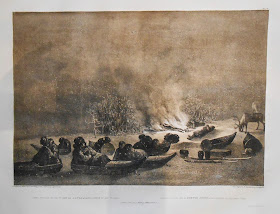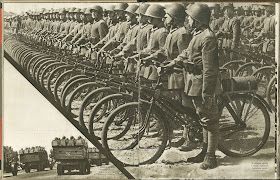Things are pretty quiet here in Rauner Library since the students left for break. We just have a few folks in doing some research, but the hustle of the term is past and the classrooms are empty. Hanover is cold and grey in their absence, but peaceful, too.
They all seemed pretty tired during finals week--wandering around in a daze, some in their pajamas. We like to imagine they are hunkered down now catching up on their sleep like in this lithographic image from Arthur de Capell Brooke's Winter Sketches in Lapland (London: J. Murray, 1827).
If the Hanover winter gets you too down, come in and take a look by asking for Stef DL971.L2 B7.
Friday, December 5, 2014
Tuesday, December 2, 2014
Oh, No!
 We have quite a few examples of books and ephemeral material that served as propaganda during the First and Second World Wars. But this one caught us a little off guard. Published in 1939 in Warsaw, L'armée et la marine de guerre Polonaises, looks like a typical 1930s show of military muscle. For the most part, it is images of tanks, airplanes, heavy artillery and troops training. But, timing is everything, so the image of Poland's bicycle brigade stands out. It proudly shows rows of Polish infantry sitting astride bicycles tricked out with rifles in the handlebars.
We have quite a few examples of books and ephemeral material that served as propaganda during the First and Second World Wars. But this one caught us a little off guard. Published in 1939 in Warsaw, L'armée et la marine de guerre Polonaises, looks like a typical 1930s show of military muscle. For the most part, it is images of tanks, airplanes, heavy artillery and troops training. But, timing is everything, so the image of Poland's bicycle brigade stands out. It proudly shows rows of Polish infantry sitting astride bicycles tricked out with rifles in the handlebars.Published just months before Germany invaded from the West and the Soviet Union from the East, the bicycle brigade is now emblematic of just how ill-prepared Poland was to face either military force. It took just five weeks for the Germans and Soviets to seize and divide Poland.
To see the book, ask for Rare UA829.P7 K63 1939.

